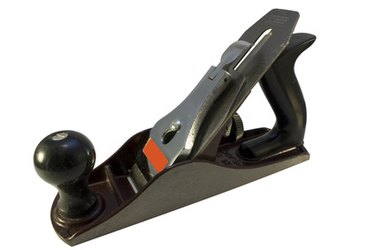Things You'll Need
Screwdriver
File
Mallet

The blade of a hand plane comes out for sharpening or replacement. To reassemble most modern planes, you need to reassemble two parts in addition to the blade: the lever cap and the cap iron, or chip breaker. The cap iron fits directly above the blade and has a hump at one end. The lever cap fits above the cap iron and has a tab-shaped lever on the back. Older wood-bodied planes use a simple wooden wedge to hold the blade in place. If your plane has a wooden body and only three separate parts -- the body, blade and wooden wedge -- it's the older kind.
Modern Planes
Step 1
Place the cap iron on top of the blade at right angles to it, with the beveled side of the blade down and the hump of the cap iron up. The cap iron is the same width as the blade and approximately the same shape, except it has no sharp point and is usually shorter than the blade. Align the locking screw through the small round central hole in the cap iron.
Video of the Day
Step 2
Swing the cap iron so it's parallel with the blade and the curved hump is toward the sharp edge of the blade. Be careful not to scratch the blade with the cap iron.
Step 3
Slide the cap iron toward the sharp edge of the blade until its end is 1/16 inch from the end of the blade. Check that the cap iron rests evenly against the blade, with its forward edge touching first. If not, disassemble it, file the underside of the cap iron until it fits, then reassemble it.
Step 4
Tighten the lock screw with a screwdriver to hold the cap iron and blade in position. Lay them in the body of the plane, sharp edge downward, aligning the holes over the cleat of the depth-adjustment lever and the lever-cap screw.
Step 5
Lay the lever cap on top with the broad end curved down toward the blade and the lever toward the back of the blade. Place it over the lever-cap screw, then push it forward to lock it underneath the screw. Press the lever down at the back to press it against the blade assembly and hold the blade in place. If the blade isn't tight, release the lever, turn the screw clockwise a quarter turn with a screwdriver, test the tightness again and repeat until the blade is tight.
Wooden Wedge Planes
Video of the Day
Step 1
Lay the blade in its angled slot in the body, with the sharp edge downward and the bevel on the underside. The blade should barely protrude below the bottom surface of the plane.
Step 2
Insert the wooden wedge, narrow side down, on top of the blade so it fits in the wedge-shaped opening designed for it.
Step 3
Tap the top of the wedge gently with a mallet to seat it firmly and wedge the blade in place.
Tip
If you have a wood-bodied plane with a depth-adjustment screw in the back, it may have a regulator that fits similarly to the lever cap. Place the regulator on top of the blade and cap iron and tighten the screw.